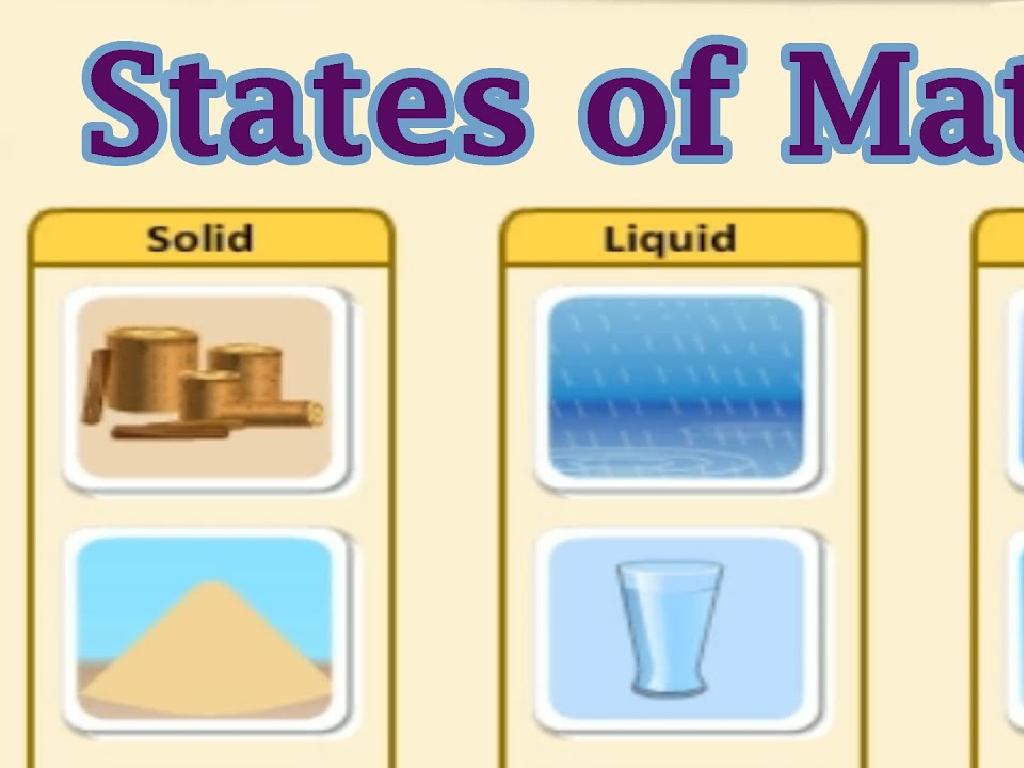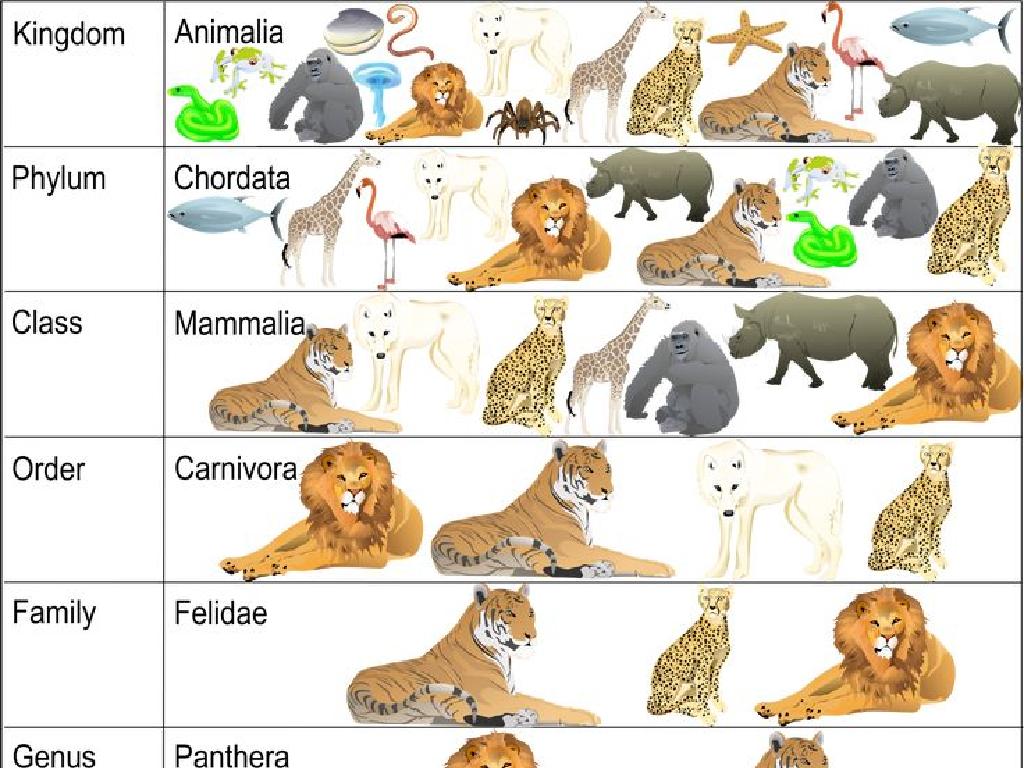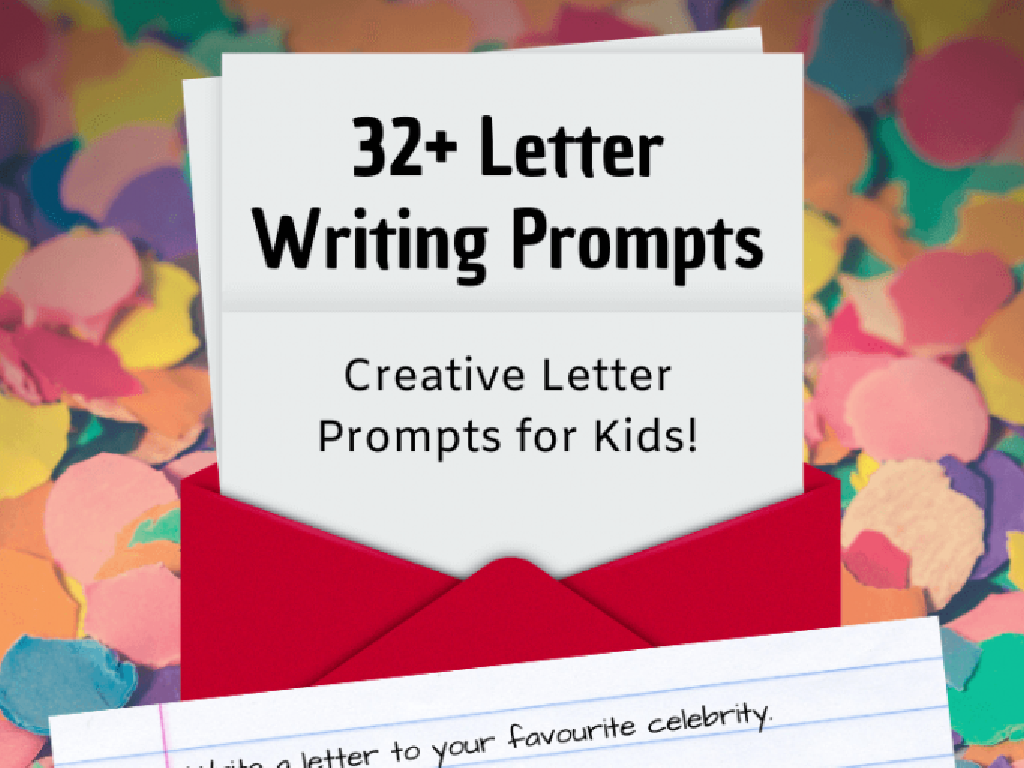Determine The Themes Of Short Stories
Subject: Language arts
Grade: Fifth grade
Topic: Theme
Please LOG IN to download the presentation. Access is available to registered users only.
View More Content
Exploring Themes in Short Stories
– What is a theme?
– A theme is the central topic or idea explored in a story.
– Finding the message
– Clues to the theme are found in the plot, characters, and setting.
– Common literature themes
– Friendship, courage, and love are examples of themes.
– Theme vs. main idea
– Theme is the lesson or message, while the main idea is what the story is about.
|
This slide introduces the concept of theme in literature, which is essential for understanding the underlying messages in short stories. A theme is not just a topic, but a perspective or insight the author offers about life or human nature. When discussing the theme, it’s important to differentiate it from the main idea; the main idea is the specific point the story is making about a particular topic, while the theme is a universal concept that readers can apply to their own lives. Use examples from well-known children’s stories to illustrate common themes and help students grasp the concept. Encourage students to think about the themes of stories they’ve read and how those themes relate to their own experiences.
Discovering Themes in Stories
– Themes are implied, not explicit
– Look for clues within the text
– Clues can be actions, dialogues, or events
– Themes convey deeper messages
– What lesson does the story teach us?
– Analyze characters & plot for themes
– How do the characters’ experiences reflect the theme?
|
When teaching students about themes, emphasize that themes are the underlying messages or the ‘big ideas’ in a story that are not directly stated. Encourage students to become detectives, looking for hints or clues in the characters’ actions, dialogues, and the events that unfold. Discuss how a theme is a deeper meaning or insight that the story is communicating to the reader. It’s often a universal statement about life or human nature. To help students grasp the concept, use examples from familiar stories and guide them in analyzing how the plot and characters’ journeys can point to the theme. This will help them understand that themes are a critical aspect of literary analysis.
Understanding Themes vs. Main Ideas
– Difference between theme and main idea
– Main idea: what the story is about
– Theme: the story’s lesson or message
– Examples to illustrate theme and main idea
– ‘The Tortoise and the Hare’: Main idea is a race, Theme is ‘slow and steady wins the race’
|
This slide aims to clarify the distinction between the main idea and the theme of a story. The main idea refers to the primary focus or what the story is explicitly about, such as the plot or topic. In contrast, the theme is the underlying message or lesson that the author wants to convey, often implied rather than directly stated. It’s a universal concept that readers can apply to their own lives. Use examples from well-known fables or short stories to help students grasp the concept. For instance, in ‘The Tortoise and the Hare,’ while the main idea is about a race between two animals, the theme is the moral lesson that perseverance and determination can lead to success. Encourage students to think beyond the plot and explore what the author might be teaching us through the story.
Exploring Themes in Short Stories
– Common themes: friendship, courage, love
– Themes of resilience: overcoming challenges
– Examples: characters facing tough times and succeeding
– The role of kindness and perseverance
– Acts of kindness and never giving up
– Relating themes to known stories
– Think of stories we’ve read and discuss the main messages
|
This slide aims to help students recognize and understand common themes in literature, specifically in short stories. Themes like friendship, courage, and love are universal and can be found in many narratives. Similarly, the themes of overcoming challenges, kindness, and perseverance teach valuable life lessons through the characters’ experiences. Encourage students to think about how these themes present themselves in stories they are familiar with, whether through the actions of the characters, the plot, or the moral of the story. In the next class, have a discussion where students can share examples of these themes from their favorite stories or books they have read in class. This will help them to connect with the material on a personal level and see the relevance of themes in everyday life.
Identifying Themes in Short Stories
– Read a story as a class
– Find clues for the theme
– Look at characters, setting, plot, and conflict for hints
– Ask about characters’ challenges
– What problems are they dealing with?
– Discuss characters’ lessons
– What do characters learn by the end?
|
This slide is aimed at guiding students through the process of identifying themes in short stories. Begin by reading a story together as a class to provide a common ground for discussion. Encourage students to pay attention to various elements such as characters, setting, plot, and conflict, as these often hold clues to the story’s theme. Prompt them to think critically about the challenges faced by the characters and what lessons they may learn as the story unfolds. These discussions will help students understand that a theme is a central message or insight into life revealed through the story. The activity will culminate in a class discussion where students can share their thoughts and learn from each other’s perspectives.
Group Activity: Theme Discovery
– Break into small groups
– Each group gets a unique story
– Discuss the story’s theme
– Think about the main message or lesson
– Write down your theme findings
– Share what you think the theme is with your group
|
This group activity is designed to foster collaboration and critical thinking as students work together to identify the theme of different short stories. Divide the class into small groups, ensuring a mix of reading abilities in each. Provide a variety of short stories, each with a clear but different theme. Encourage students to discuss the plot, characters, and any recurring ideas or messages that could represent the theme. They should write down their agreed-upon theme and be prepared to explain how they arrived at their conclusion. As a teacher, circulate among the groups to guide discussions and offer hints if needed. Possible themes could include friendship, courage, honesty, or perseverance. This activity will help students understand that a theme is a universal idea that extends beyond the story.
Share and Reflect: Exploring Themes
– Groups share their themes
– Each group talks about the theme they found in their story.
– Discuss the variety of themes
– Why might different groups find different themes in the same story?
– Reflect on theme importance
– Understanding theme helps us grasp the story’s deeper message.
– How themes relate to real life
– Themes can teach us lessons about life and human nature.
|
This slide is meant to facilitate a classroom discussion where students will engage in sharing the themes they have identified in various short stories. Each group will have the opportunity to present their findings and discuss how they arrived at their interpretation. The class will then explore the diversity of themes, understanding that different readers may connect with different aspects of a story. Reflecting on the importance of theme, students should consider how recognizing the theme provides insight into the author’s message and can offer valuable lessons applicable to their own lives. Encourage students to think critically about how the themes they’ve discovered relate to broader life experiences and societal issues.
Class Activity: Crafting Stories with Themes
– Write your own short story
– Decide on a clear message
– Think about lessons or morals you want to express
– Use creativity and imagination
– Share your story next class
– We’ll discuss the themes of each story together
|
This activity is designed to help students understand the concept of themes in literature by engaging them in the creative process of writing. Encourage students to think about a message or lesson they want to share through their story, which will become the theme. They should use their creativity to come up with characters, a setting, and a plot that express this theme. Remind them that a theme is a universal idea that speaks to everyone. In the next class, we’ll have a sharing session where students can present their stories and discuss the themes they’ve incorporated. This will not only help them in identifying themes but also in understanding how a theme is woven into the narrative. Provide a few examples of common themes such as friendship, courage, or the importance of honesty to get them started.






